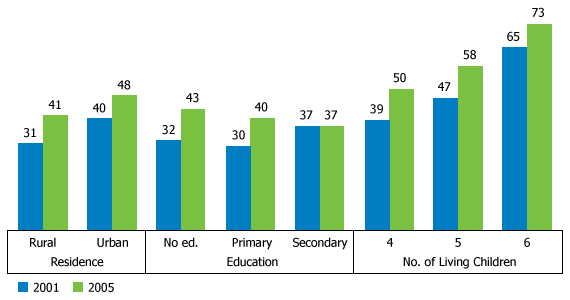
New Book on Ethiopian Demography Explores Complex Interplay of Social and Environmental Forces
(June 2011) “Spatially and generationally there are two ‘Ethiopias,’ ” says demographer Charles Teller of Addis Ababa University’s Center for Population Studies (CPS) and George Washington University’s Department of Global Health. There is a demographic gap between rural areas where women average six children each and the capital city, Addis Ababa, where about two children or fewer is the norm.
Teller, a former PRB visiting scholar, also sees an important divide between youth and their parents. “The younger generation that has reached high school doesn’t expect to continue subsistence farming in isolated rural areas as their parents did. They want access to modern goods and technology—cars, television, computers, cell phones, health insurance, as well as to urban employment.”
A new book Teller co-edited with long-time colleague Assefa Hailemariam, also a demographer and professor at Addis Ababa University’s CPS and founder of the Ethiopian Society for Population Studies, sets out to “unravel” Ethiopia’s complex population dynamics. The Demographic Transition and Development in Africa: The Unique Case of Ethiopia (London: Springer, 2011) examines:
- Slowly declining population growth rates with rapidly declining child mortality.
- Very high chronic undernutrition (stunting).
- Already low urban fertility but still very high rural fertility.
- High population-resource pressure along with rapidly growing small urban places.
The book’s authors also explore apparent paradoxes: The percentage of illiterate women and the number of food-insecure people in Ethiopia are Africa’s highest, yet Ethiopia is one of the few African countries on track to meet most of the UN’s Millennium Development Goal objectives (except maternal mortality) in health, nutrition, and education for the year 2015.
Percentage of Currently Married Rural Women Ages 15-19 Who Want No More Children by Residence, Education, and Number of Living Children, 2001 and 2005

Sources: Central Statistical Agency and ORC Macro, Ethiopia Demographic and Health Survey, 2000 (Addis Ababa and Calverton, MD: Central Statistical Agency and ORC Macro, 2000); and Central Statistical Agency and ORC Macro, Ethiopia Demographic and Health Survey, 2005 (Addis Ababa and Calverton, MD: Central Statistical Agency and ORC Macro, 2006).
The 350-page volume includes the contributions of more than two dozen researchers, reflecting nearly 20 years of collaborative research, training, and policy advising in Ethiopia. The authors present a “revised framework” for studying the demographic transition (the historical shift of birth and death rates from high to low levels in a population). Specifically, they argue for an understanding of demographic change that incorporates various human responses to drought, climate variability, epidemics, civil unrest, refugee movements, poverty, food shortages, environmental degradation, and splintered land holdings.
Using national surveys and censuses, specific cases studies, and micro-level data, individual chapters explore the variety of ways Ethiopians have adapted to this complex interplay of forces as well as the multiple factors influencing migration patterns, and birth and death rates. The book’s authors detail trends that suggest Ethiopia is on the brink of a drop in rural fertility: declining child mortality, a rapid increase in girls’ school enrollment, an increase in the age of marriage, growing economic links between rural and urban areas, and a sharp decline in the desire for additional children by parents who already have four living children.
The changing values and attitudes of young people will likely play a pivotal role in future demographic change, reports Teller. “Adolescent women desire continued education in their teen years and to become economically active,” he notes. “While their older sisters may have been married at 16, the younger sisters want to wait until the new legal age of 18, and to choose not only when to get married, but even to whom. Programs and policies promoting the value of the ‘girl child’ are changing the sociocultural climate.”
In the book’s foreword, William Butz, former PRB president, praises the authors for not “whining” about inadequate data but “in important instances, improving on them through new and ongoing data collection efforts.”
“The refreshing sense of what we can know is much stronger in these papers than the debilitating sense of what we wish we could know,” writes Butz, now at the International Institute of Applied Systems Analysis in Vienna, Austria.
Paola Scommegna is a senior writer/editor at the Population Reference Bureau.
